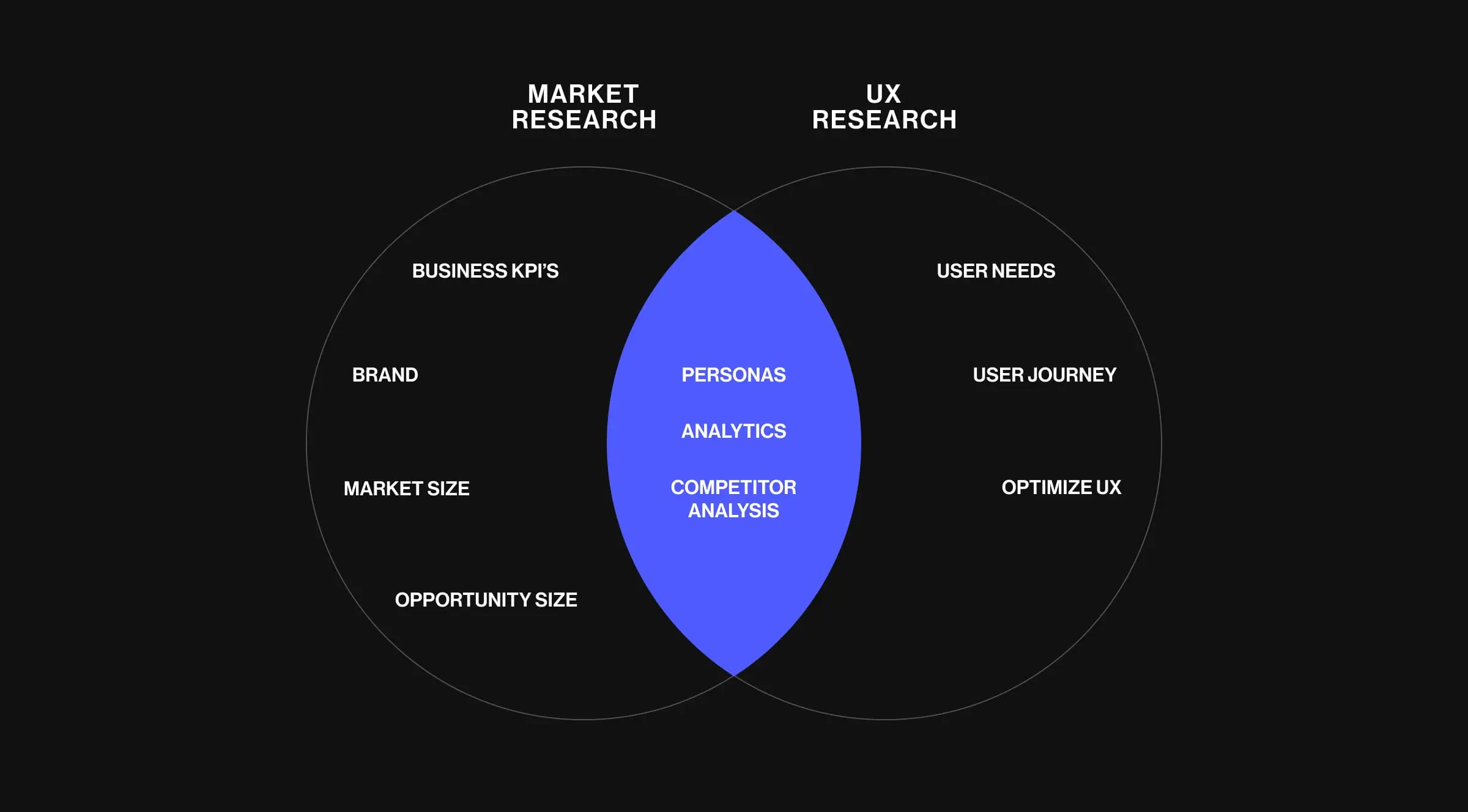When Microsoft Xbox faced plummeting engagement, user experience was the culprit. Menus felt heavy and navigation was far from intuitive. To fix the problem, Microsoft chose observation over assumption, and it paid off. The team studied how people actually used the platform, redesigned the flow, and turned Xbox Live into one of the most engaging ecosystems in gaming.
So, is user research harmful? Not at all. The real harm comes from skipping it or doing it wrong. In this article, you’ll see why UX research is worth the investment, how it differs from market research, and the common myths holding teams back. Along the way, we’ll look at the data and practical lessons that prove why research is the backbone of products that last.
Key takeaways
- Market research looks outward, UX research looks inward. One defines where to play, the other defines how to win.
- Myths kill progress. Research doesn’t slow you down. It accelerates launches by preventing costly rework.
- Bad research misleads. No research blinds. Done right, UX research becomes your shield against wasted development costs and missed opportunities.
Why UX research is an investment worth making
User research pays off in hard numbers. It’s an insurance policy and a growth engine rolled into one.
And here’s the catch. You don’t really pay for UX research. Rather, you pay for not doing it. Consider this:
- Every $1 spent on UX can return up to $100 – a compounding ROI most marketing campaigns can’t match.
- 70% of Gen Z users expect websites to know intuitively what they want.
- Increasing customer retention rates by 5% can lift profits by 25%.
- Fixing design flaws after launch can cost up to 100 times more than solving them in the prototype phase.

Smart UX research makes your business harder to disrupt. By validating features early, you cut wasted development costs. By aligning flows with real user behavior, you boost conversions. And by making interactions frictionless, you earn loyalty that compounds into long-term revenue.
Market research vs. UX research: differences to keep in mind
Market research and UX research are often used interchangeably, but they serve different purposes in product strategy. Think of them as two lenses that sharpen the same picture. Market research looks outward at the size, scope, and positioning of opportunities, while proper UX research looks inward at how users actually experience your product.
Here’s how the two compare:
Market research tells you where to play. UX research tells you how to win. And in the middle, shared insights like UX personas and analytics keep your product strategy and user experience tightly aligned.

Myths debunked: why UX research is more important than you think
Many teams skip the user research process because of myths that don’t hold up under scrutiny. Let’s dismantle them:
And the verdict is straightforward. Skipping UX research isn’t saving your company time or money. It’s betting against your own product.
Real risks of poorly conducted UX research vs. skipping it altogether
“Poorly conducted research can misguide you. Yet, skipping research altogether guarantees bigger losses. The solution isn’t to abandon research. It’s to do it right with experienced teams.”
{{Kyrylo Lazariev}}
Risks of poor UX research
Now let’s address where the “harmful” idea comes from: badly executed UX research.
- Biased questions lead to unreliable insights. Subtle wording nudges research participants into confirming what the product team already believes. This misstep turns research sessions into validation theater rather than a discovery process.
- Unrepresentative samples equal distorted conclusions. Testing users who don’t match your target audience tells you less than doing no research at all.
- Confirmation bias is akin to reinforcing incorrect ideas. Teams cherry-pick quotes or behaviors that fit their assumptions, ignoring evidence that contradicts them.
Risks of skipping UX research
If bad research gives you false confidence, skipping research altogether strips you of any confidence at all, leaving product decisions to gut instinct.
- Feature graveyards. Products ship bloated with functionality no one touches because no one validated the actual user needs.
- Sky-high churn and low retention. Users abandon tools that feel confusing or irrelevant.
- Draining redesigns. Revising usability testing after launch creates technical and financial debt.
- Competitors leap ahead. While your team relies on assumptions, competitors who validate their decisions with users capture loyalty and market share.
Neither path, poor research nor no research, is sustainable. The former wastes resources by leading you astray. The latter leaves you blind in a competitive market. The only solution is doing research well, with experienced teams who understand both methodology and business context.
Real benefits of UX research: practical insights from Lazarev.agency
Good UX research saves businesses from building on assumptions. Done right, it clarifies what users need, highlights barriers they face, and reveals the levers that drive engagement and revenue. Below are the four benefits UX research experts from Lazarev.agency, an AI UX design agency listed number one among US AI design agencies, point out as critical.
1. It unlocks conversions
When you understand where users get stuck, you can redesign flows that lead them straight to action.
💼 Case in point: For We Build Memories, a top Etsy seller moving into B2B, research revealed that their text-heavy interface left users confused. By studying reseller behaviors and identifying barriers in the customization flow, we simplified product creation and invoicing. The outcomes prove that the UX research project was worth the effort: 20% higher conversion rates, 15% revenue growth, and a 30% drop in churn.
2. It simplifies the complex
Research simplifies the experience for different user groups without diluting value.
💼 Case in point: Corporate learning platform Flying Penguins struggled with balancing two audiences: facilitators and participants. Our research highlighted pain points in preparation and session tracking. By restructuring journeys based on observed needs, we designed a timeline-based dashboard for facilitators and a low-friction DISC flow for participants. Engagement improved, and the platform repositioned itself as a scalable enterprise solution.
3. It fuels retention
Insights into user motivation help create experiences people return to on a regular basis.
💼 Case in point: Wellness platform WellSet had rich content but weak retention. Research revealed that users felt lost in a passive library of videos. Through user studies, we identified the need for new features like timers, live class integration, and personalized recommendations. The redesign led to a 30% boost in retention, 500K+ active users, and $3.1M+ in new funding.
4. It elevates products with contextual insight
By studying real-world behavior, research aligns tools with how teams actually work.
💼 Case in point: With GoPingu, a project management tool, the research focus was on real-world workflows. Teams struggled with scattered data and heavy routines. By observing how managers and team members collaborated, we introduced kanban-style layouts, interactive dashboards, and streamlined mobile UX.
Why UX research is your safest bet
User research itself is never harmful. The harm comes from skipping it or executing it carelessly. Done right, UX research:
- Protects you from wasted development costs.
- Gives you confidence in product decisions.
- Keeps your users engaged and loyal.
At Lazarev.agency, your AI product design partner, we’ve seen products jump from seed stage to acquisition because teams invested in structured, expert-led user research. If you’re building digital products, don’t gamble. Contact us, and we’ll help you leverage user experience research to turn assumptions into evidence and design into growth.





























.webp)



















